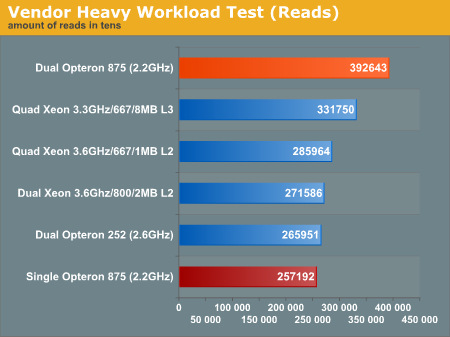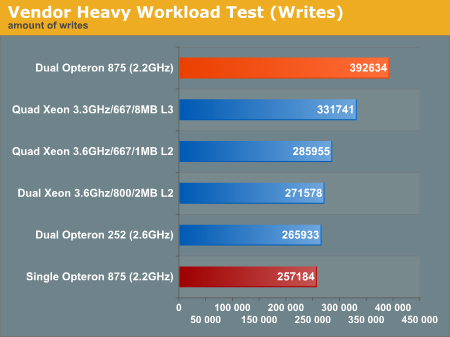AMD's dual core Opteron & Athlon 64 X2 - Server/Desktop Performance Preview
by Anand Lal Shimpi, Jason Clark & Ross Whitehead on April 21, 2005 9:25 AM EST- Posted in
- CPUs
Order Entry Results
Our Vendor test has received quite a bit of interest from certain processor vendors; rightfully so, as the workload is quite difficult to recreate.As you can see from the results below, there are some interesting conclusions that you can draw:
- The Dual Opteron 875 took the lead by 18% over the fastest Quad Intel. This should come as no surprise as we have seen in the past that the memory bandwidth limitation of the Intel FSB architecture does not allow the quads to really stretch their legs. On the other hand, the Integrated Memory Controller of the Opterons allow them to pull ahead.
- The additional L3 cache of the Quad Xeon 3.3GHz allows it to outperform the Quad Xeon 3.6GHz by 16%.
- The Quad Xeon 3.6GHz with the 667MHz FSB is only able to outperform the Dual Xeon 3.6GHz 800MHz FSB by 5%.
- The dual Xeons are able to outpace the dual 252's by 2%, and the single 875 by 5%. The Xeons success here can be attributed to the additional L2 cache.
- The Dual Opteron 875 demonstrated nice scalability by servicing 52% more requests in the same period as the single Opteron 875.













144 Comments
View All Comments
liebremx - Thursday, April 21, 2005 - link
Anand, great reading as always.
I have an observation:
On the 'Development Performance - Compiling Firefox' section you write
"This particular test is only single threaded, ..."
Why not launch a multithreaded build?
"make -j3 -f client.mk build_all"
Jalf - Thursday, April 21, 2005 - link
Makes good sense for AMD to keep their (server) dualcore chips pricey. AMD has limited manufacturing capacity, and they have best singlecore solution. In other words, they might as well keep the dualcore prices high, to a) make more money in cases where people are willing to fork over lots of money, and b) keep people who are on a budget interested in their singlecore offerings, at least until their new fab goes online.GentleStream - Thursday, April 21, 2005 - link
I have some comments about the Firefox compile test. First, thanks alot for including it. Now I have some comments about it. First, you are using GNU make and it supports parallel compiles. So, you should be able to replace the line:make -f client.mk build_all
with the line:
make -j 2 -f client.mk build_all
to perform a parallel compile using 2 processors. The -j option specifies how many processors or threads you are using. You can do parallel compiles on a single processor machine as well as multi-processor or multi-core machines. It is often the case that using -j 2 or -j 3 on a single processor machine will give the best results because of it's allowing the overlaping of cpu computations and I/O.
You don't say whether you did a debug or optimized build. I would recommend doing both the debug and optimized builds and reporting the results of both. When doing parallel optimized compiles, you may want to make sure you are not swapping although for the server tests it looks like you have plenty of memory - 4 GBytes. I did not see immediately how much memory you were using for the X2 tests. Anyway, I would recommend doing both debug and optimized compiles with -j n where n is 1, 2, 3, and 4 or perhaps just 1, 2, and 4. Since compiles are essential to development work and also embarassingly parallel, this should provide a really good comparison of the multitasking capabilities of these systems.
Hope you can do this or at least some of it and thanks alot for adding a really good compile test to your test suite.
Dave
michaelpatrick33 - Thursday, April 21, 2005 - link
The server market is where AMD is going headed to get large margins in their chips. With Supermicro joining the AMD camp (they must have seen the performance of the Opteron dualcore, blinked their eyes and said, "we're in") Dell is left alone holding Intel only product lines. Intel will not have a response on the server front until Q1 2006. That is troubling for Intel because it give AMD six months of market buildup and Fab36 time to come online and increase volume tremendously. It should be interesting.Imagine a 4800+ on a 939 DFI board running at 2-2-2-8 1t timings versus the P4 Extreme dualcore. Drooling just thinking about having either processor, but especially the AMD
erwos - Thursday, April 21, 2005 - link
"AMD would probably have problems delievering a lower cost dual core in quantities ."This is exactly it. Why should AMD let demand outstrip supply? Just jack up the price until you've got just enough demand to consume your supply.
I mean, yes, I'd love an Athlon64 X2 5000+ with 1mb of cache for ~$250, but that's life. AMD stockholders should be pleased with this decision.
There's also the impending move to socket M2 to consider... the Athlon64 X2 makes sense for people with very low-end A64's, but M2 is going to be the better upgrade path for FX and/or 3800+ users. I would be surprised to see any 939 Athlon64's past 5200+.
eetnoyer - Thursday, April 21, 2005 - link
While our desires as desktop users are for high volumes of X2s at low prices, we have to balance that with what AMD as a company needs to survive...money. AMD is currently capacity constrained with regard to dual-core CPUs with only Fab30. They have entered into agreements with both IBM and Chartered for additional capacity (probably on the lower end chips), but that won't come online until late this year. Just before production starts to ramp at Fab36.In the meantime, AMD has stated that their order of priority goes Server -> Mobile -> Desktop with the profitability motive in mind. For most users that will be heavily into the multi-tasking benefits of dual-core CPUs, spending $5xx for the low-end X2 vs $1000 for the PEE 840 will be a no-brainer. Seeing how that is a small minority of users, AMD can reasonbly supply the demand for them while still maintaining the highlest level of availability of dual-core Opterons at much better ASPs. Remember that AMD wants to capture as much market share in the server market as possible while Intel has no response.
As a share-holder, I hope that the demand for dual-core Opteron is deafening based on the incredible price/performance ratio (thus limiting their ability to produce X2 in high quantity). As a middle-of-the-road desktop user, I'm quite content with my mildly OC'd A64 for the next year or two.
ksherman - Thursday, April 21, 2005 - link
w00t! Ill have to read it later tho...MrHaze - Thursday, April 21, 2005 - link
Certainly impressive.I think it is important to remember that the "Athlon64 X2" was actually an Opteron running ECC RAM at 2T on a less-than-stable motherboard. I think it is best think of this as a comparison of Intel's dual cores, AMD's single cores, and a hog-tied Athlon64 X2.
Makes you wonder how an actual X2 with fast memory on a fast motherboard will perfom.
Regardless, I'm really excited about the upgrade potential, and I hope that AMD sticks with socket 939 for a long while.
Mr.Haze
kirbalo - Thursday, April 21, 2005 - link
Great review Anand...Thanks for fixing your gaming bar charts...they were wacked before!Tapout1511 - Thursday, April 21, 2005 - link
Sure would have been nice if they had included a single core A64 at 2.2GHz w/ 1MB cache (3500+ right?) to illustrate instances where the extra core was useful and when it wasn't.Oh well.